
Quantum Efficiency Tester
PL/EL Integrated System
PV-Reflectumeter
3D Confocal Microscope
In-Line Four Point Probe Tester
Four Point Probe Tester
In-Line Thin Film Thickness Tester
Raman Spectrometer
FTIR Spectrometer
Spectrophotometer
Automatic Spectroscopic Ellipsometer
Contact Resistance Tester
Ultra depth of field 3D microscope
Auto Visual Tester
VMM PV Vision Measuring Machine
Solar Cell Horizontal Tensile Tester
Steady State Solar Simulator for Solar Cell
Solar Cell UV Aging Test Chamber
Solar Cell Comprehensive Tensile Tester
Visual Inspection Tester
Wet Leakage Current Tester
PV Module EL Tester
PV Module UV Preconditioning Chamber
Steady State Solar Simulator for PV Module
Current Continuous Monitor
Potential Induced Degradation Test
Bypass Diode Tester
LeTID Test System
Reverse Current Overload Tester
Impulse Voltage Tester
Hipot Insulation Tester
Ground Continuity Tester
Hipot Insulation Ground Tester
Damp Heat Test Chamber
Humidity Freeze Test
Thermal Cycle Test Chamber
Dynamic Mechanical Load Tester
Static Mechanical Load Tester
Hail Impact Tester
Robustness of Termination Tester
Module Breakage Tester
Cut Susceptibility Tester
Peel Shear Strength Tester
Universal Testing Machine (Single-arm)
Universal Testing Machine (Double-arm)
Glass Transmittance Tester
Acetic Acid Test Chamber
EVA Degree of Crosslinking Test System
Junction Box Comprehensive Tester
Drop ball tester
Semi-automatic scanning four-probe tester
Stylus Profilometer
Maximum Power Point Tracker
Perovskite Glass Transmittance Tester
Perovskite P1 Laser Scribing Multifunctional Testing Machine
Perovskite Online PL Tester
Perovskite Online Sheet Resistance Tester
Online Perovskite Film Thickness Tester
Perovskite Process Inspection Workstation
Portable IV Curve Tester
Portable EL Tester
Portable Thermal Imaging Tester
Solar Module Multi-Channel Testing System
PV Inverter Power Quality Tester
Drone EL Tester
IV Tester
IVEL Cell Sorting Machine
Influence of Anti Reflective Coating on the Performance of Solar Cells
Date : 2024-09-05Views : 205
Photovoltaic power generation is the effect of converting solar energy into electrical energy. The surface reflectivity of solar cells without anti reflective coatings is very high, with over 30% of incident light reflecting off the silicon surface. Therefore, the main challenge facing the performance of solar cells is reflection loss. Light capture, surface texturing, and anti reflective coatings are the most widely used methods to reduce reflection losses. The PV-Reflectometer from Millennial Solar is a powerful tool for solar cell manufacturers to detect reflectivity, which can test the reflectivity intensity of solar cells to different wavelength ranges of light. Using a diffraction grating spectrometer, dispersion is achieved through a grating to obtain higher resolution.
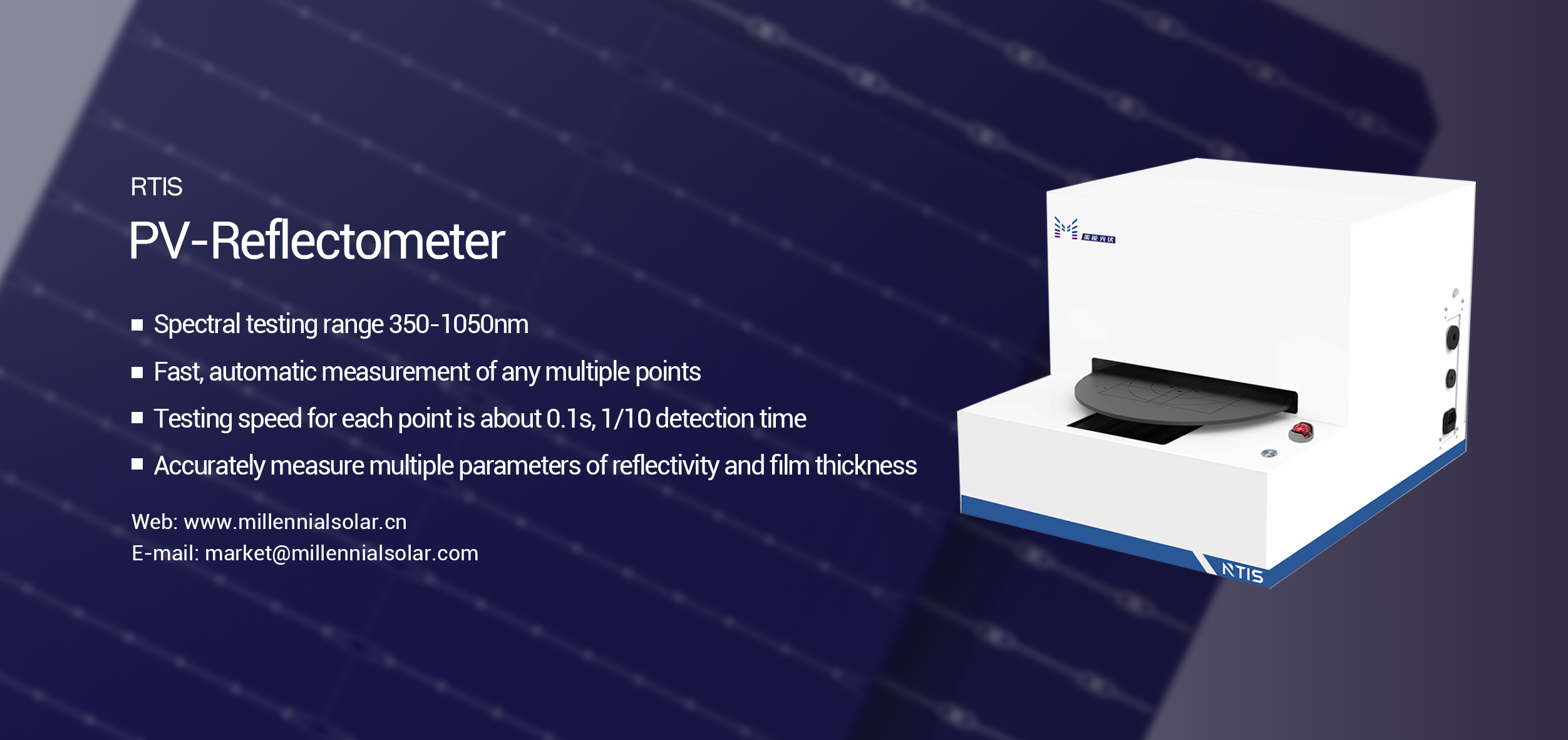
Anti reflective coating theory
Anti reflection coating (ARC) plays a crucial role in solar cells, with the main purpose of reducing light reflection on the surface, thereby increasing light transmittance and improving photoelectric conversion efficiency. Most solar cells are coated with anti reflective coatings, and a well-designed front surface anti reflective coating can reduce the reflectivity of the cell's front surface from 30% to below 5%.
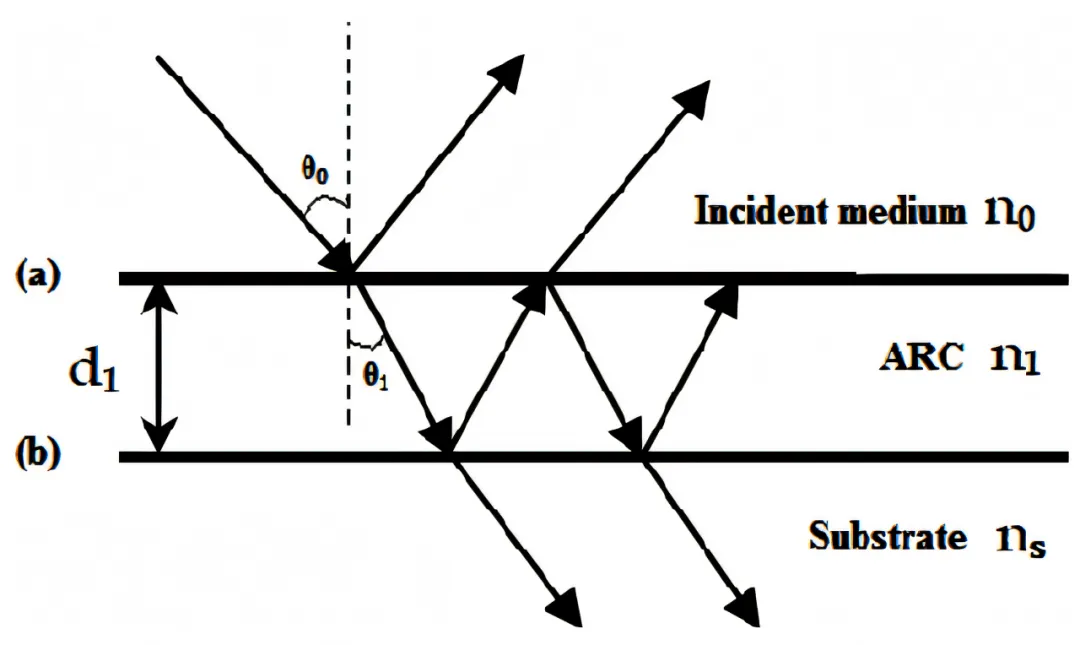
Reflection at the interface between two media
The above figure illustrates the principle of "light interference in thin films" (which is based on the interference phenomenon that occurs when light waves reflect and transmit between different media interfaces). The light reflected from interfaces a and b undergoes destructive interference, thereby transferring its energy to cell. When the incident light is normally irradiated on the silicon surface covered with a transparent layer with a thickness of d1, the expression for the reflected energy is:

For transparent layers with zero reflectivity:

Single layer anti reflective coating
The single-layer anti reflective coatings (SLARC) of different materials and their refractive indices are shown in the following table.

Single layer anti reflective coatings of different materials and their refractive indices
In order to improve the performance of solar cells, it is necessary to consider the distribution of the solar spectrum and the relative spectral response of silicon, and choose a reasonable wavelength. The energy peak in the solar spectrum appears at 0.5 μm, while the relative spectral response peak of silicon cells is in the wavelength range of 0.8-0.9μm. Therefore, the wavelength range with the best anti reflection effect is 0.5-0.7μm.
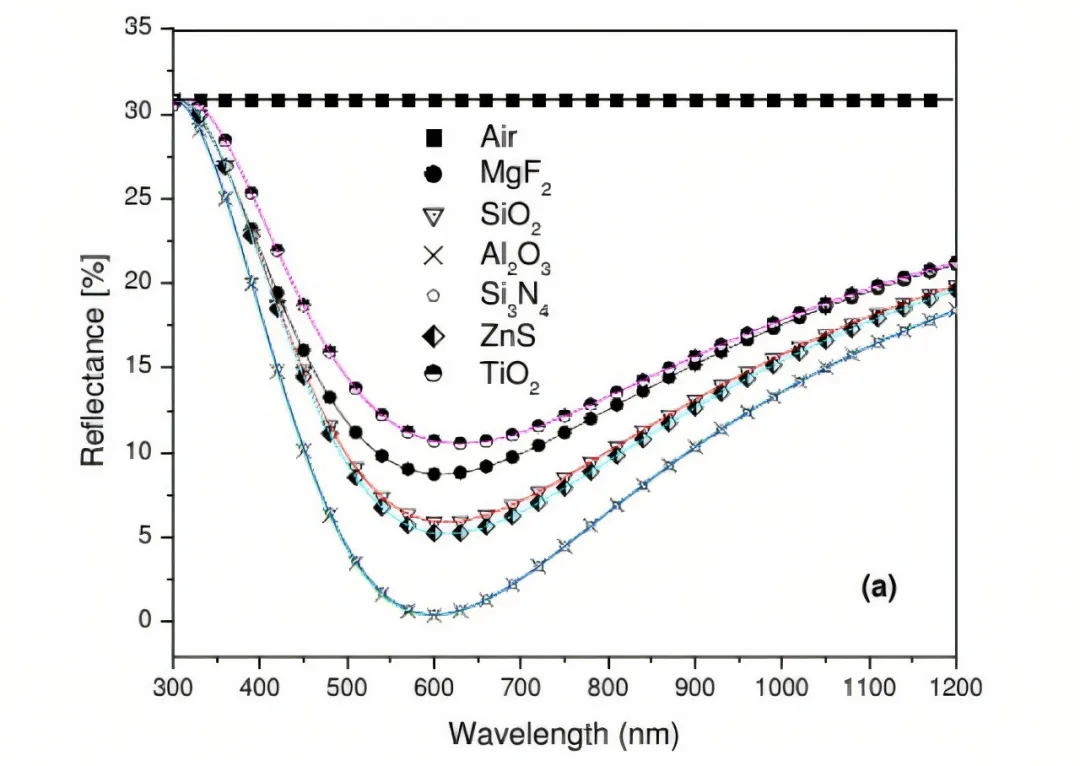
The reflectivity of uncoated and single-layer anti reflection layer coated silicon varies with wavelength
From the graph, it can be seen that the reflectivity of silicon cells without anti reflective coatings is very high (30%). When the wavelength is greater than 500nm, the reflectivity of silicon coated with SLARC is less than 20%, and when the wavelength is 600nm, the reflectivity of silicon coated with Al2O3 and Si3N4 is less than 0.4%. The reflectivity is minimum at only one wavelength, while it is higher at other wavelengths. Gradually increasing on the high wavelength side and sharply decreasing on the low wavelength side. Silicon solar cells have anti reflective coatings that help significantly reduce reflectivity.
Double layer anti reflective coating
Further reduce reflectivity through double-layer anti reflective coating (DLARC). For double-layer anti reflective coatings, the expression for reflectivity is more complex, expressed as:

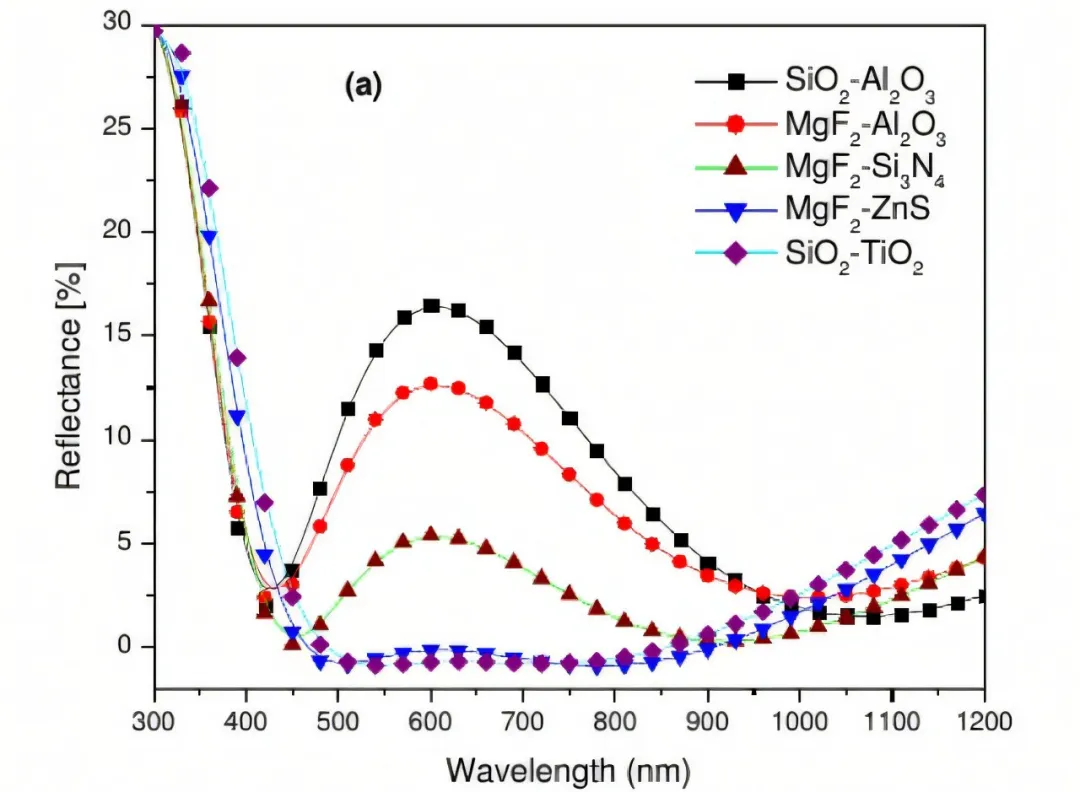
The reflectivity of silicon solar cells with DLARC varies with wavelength
The above figure shows the variation of reflectivity with wavelength. The reflectivity curve of DLARC is W-shaped, which means that the reflectivity reaches its minimum value at two corresponding wavelengths and can be reduced over a wide wavelength range (400-1200nm). It can be clearly seen from the figure that DLARC performs much better than SLARC. The DLARC reflectivity of MgF₂/ZnS and SiO₂/TiO₂ is almost negligible in the wavelength range of 450-900nm.
The influence of anti reflective coating on the performance of solar cells
Evaluate the performance of solar cells with anti reflective coatings, including parameters such as short-circuit current (Isc), open circuit voltage (Voc), fill factor (FF), and efficiency (η), as shown in the following table:

Data of SLARC and DLARC silicon solar cells under AM 1.5 irradiation
From the table, it can be seen that the efficiency of silicon solar cells without anti reflective coatings is 9.3%, while the efficiency of single-layer anti reflective coatings of Si3N4 is 13.6%. For double-layer anti reflective coatings of MgF2/ZnS and SiO2/TiO2, the efficiency of solar cells reaches 14.28% and 14.34% respectively.
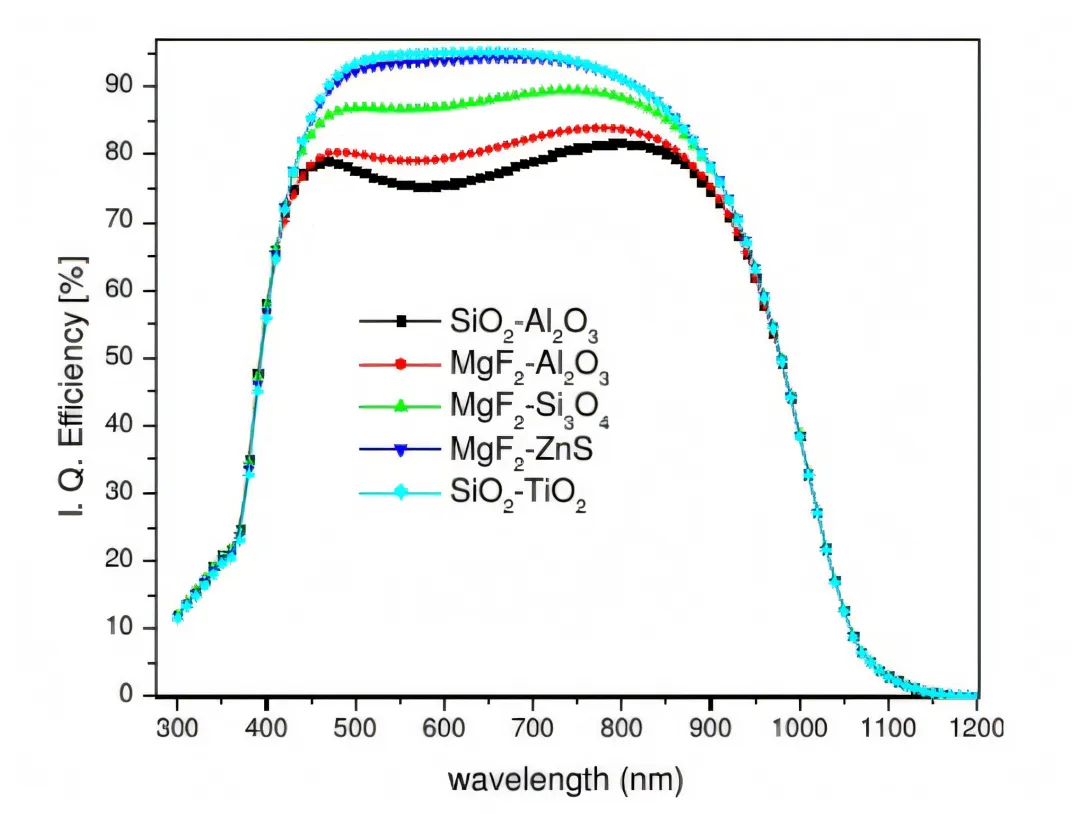
The variation of internal quantum efficiency with light wavelength
For MgF2/ZnS and SiO2/TiO2 in double-layer anti reflective coatings, the internal quantum efficiency is greater than 95% in the wavelength range of 450-900nm, with an increase of about 52% in short-circuit current. The improvement of internal quantum efficiency corresponds to an increase in short-circuit current, indicating that DLARC helps to enhance the utilization efficiency of photons in solar cells, thereby improving their performance.
From this, it can be seen that SLARC can partially improve the performance of solar cells, while well-designed DLARC can greatly improve performance. By applying SiO2/TiO2 DLARC, low reflectivity can be achieved, short-circuit current increases from 2.18 to 3.32, and photovoltaic efficiency is about 14.34%.
PV-Reflectometer
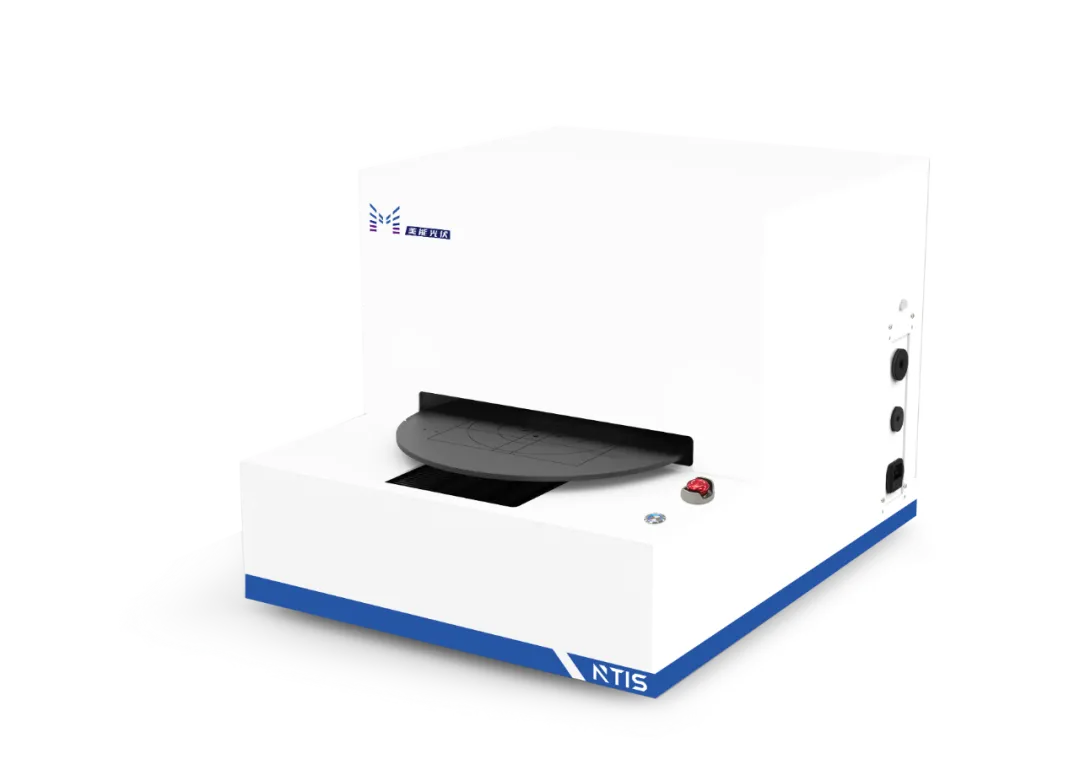
E-mail: market@millennialsolar.com
PV Reflectometer RTIS excites cells through diffuse reflection and detects them using an 8-degree angle spectrometer. The machine and guide rail help to conveniently and quickly feed samples, achieve sample positioning, and improve the work efficiency of users.
·The spectral testing range can reach 350-1050nm
·Fast and automatic measurement of any multiple points
·The testing speed for each point is about 0.1s, and the detection time is only 1/10 of the traditional reflectivity
·Accurately measure multiple important parameters such as reflectivity and film thickness
Anti reflective coatings can reduce the reflectivity of silicon solar cells, thereby increasing photon absorption, improving short-circuit current and efficiency. PV Reflectometer is a powerful tool for solar cell manufacturers to detect reflectivity. It can test the reflectivity intensity of solar cells to different wavelength ranges of light. The test results will be calculated by software based on the photoelectric signal and presented in a visualized curve, which is beneficial for users to systematically characterize the reflectivity of solar cells

































































